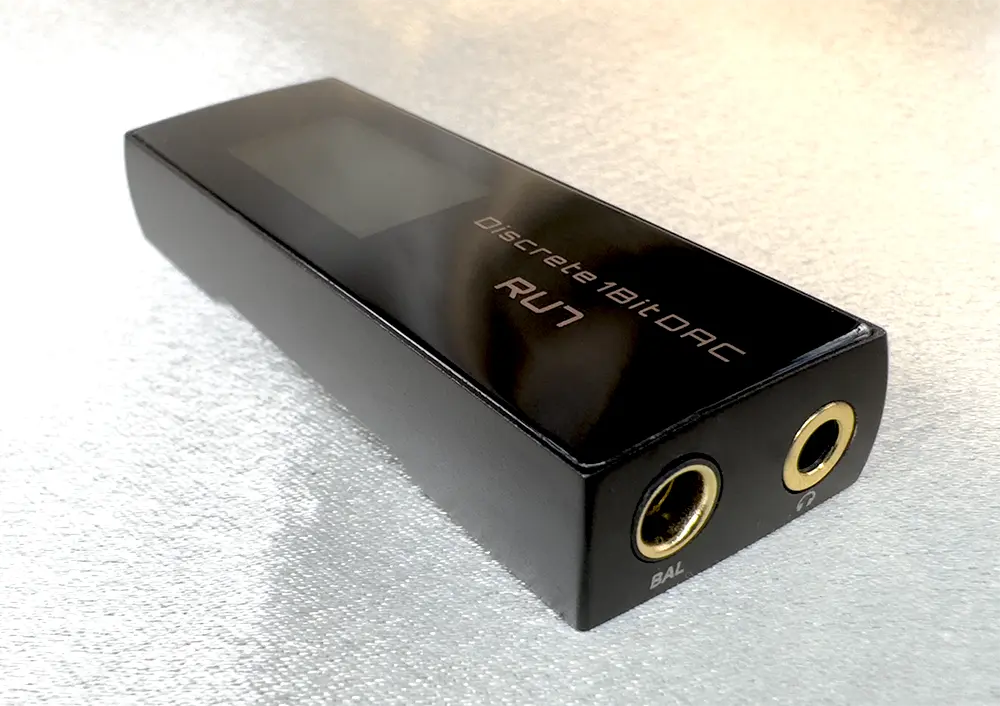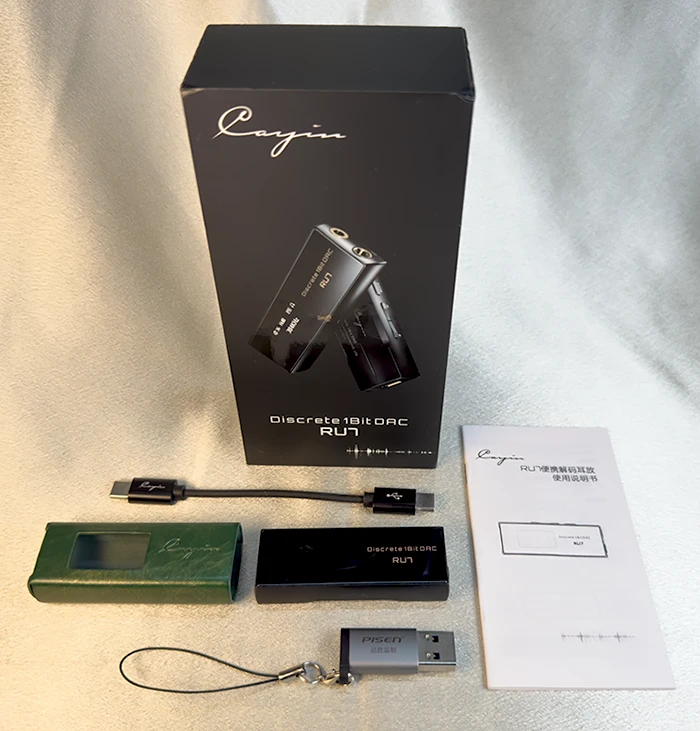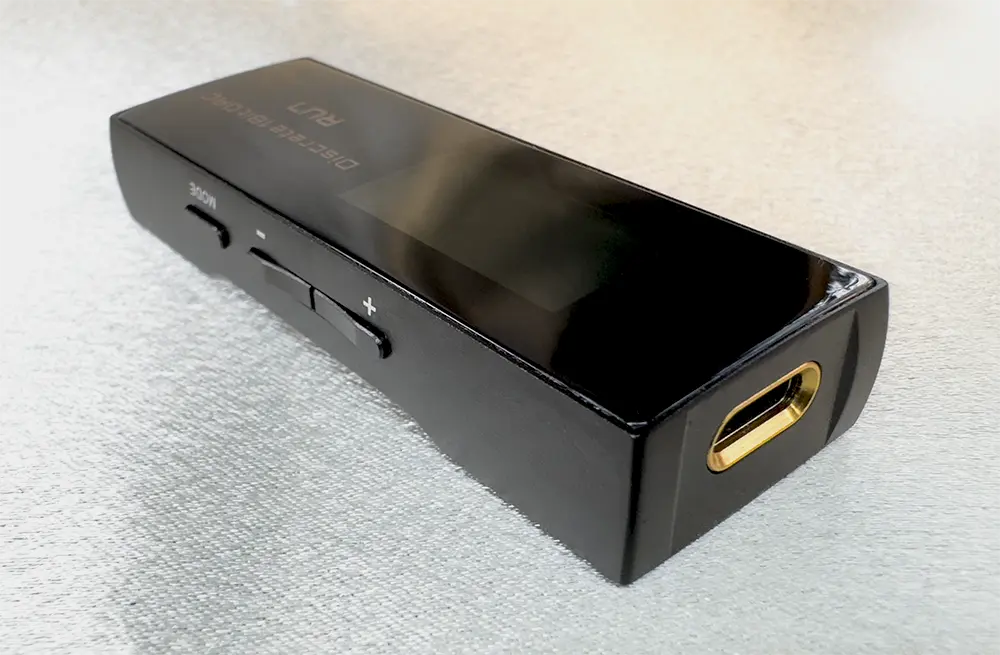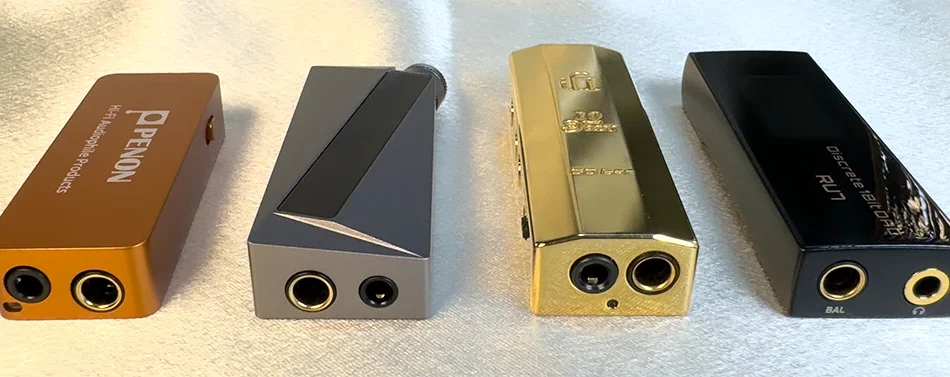Cayin RU7 Review

Last year Cayin announced their new N7 player, the first on the market to utilise a 1bit DSD DAC. Rather than employ an off-the-shelf DAC chip from AKM, Cirrus Logic or ESS, the N7 uses 128 precision resistors to convert PCM data into DSD format, in a manner reminiscent of, yet distinct from R2R players.
I’ve yet to try the N7 but have read positive reports of its’ tonality in particular, so when Cayin announced their new RU7 dongle would also feature the same 1bit approach I was intrigued.
The problem with dongles is there’s so little available space to innovate that most of them use lower-end DAC chips and end up sounding fairly similar. Whereas the RU7 takes a different approach, and even uses two PCB’s sandwiched together to facilitate a more complex circuit.
My expectations for RU7 were fairly high, and as you’ll discover they’ve not been let down!
Packaging

The USD $289 Cayin RU7 arrives in a small cardboard box which contains a manual, USB-C to USB-C cable, and a USB-A to USB-C adapter.
Cayin have also included a leather case which does a great job of protecting the RU7 during use. The leather is surprisingly supple though green wouldn’t be my preferred colour of choice, but it’s nice having a case right out of the box.
Features & Ergonomics

The RU7 is the first dongle on the market to utilise a 1bit DAC, which essentially uses precision-matched resistors rather than a DAC chip to process sound. It features two gain levels, a small screen that displays the current volume level & sample rate, and lets you to automatically convert PCM content into your choice of DSD64, 128 or 256. It supports PCM to 384 kHz and DSD up to DSD256, with 400mW of output power to its’ 4.4mm jack.
At 24.1 grams the RU7 is extremely light but feels very well-finished, with two physical buttons to control volume and another to activate & scroll through the menu system.
It’s worth mentioning the RU7 is the only dongle in this shootout to include a fully-fledged Line Out which functions from both the 4.4mm & 3.5mm jacks, bypassing the internal amplifier for when you choose to pair it with an external amp.
Sound Performance
I tested the RU7 with a USB-C iPhone 15 Pro & M1 Macbook Air, using Noble Audio Spartacus IEMs.
The RU7 sports a terrific balance of tonality & technicality, and there’s something particularly special about the flavour of its’ 1bit DAC which no other dongle I’ve tried has captured.
This is best demonstrated in the midrange, where vocals on the RU7 are very forward – really grabbing your attention with rich sense of warm fullness and effortless resolution that’s at least on par with any other dongle out there.
Bass is biased more towards midbass and is impressive by dongle standards, though kept in check to avoid overshadowing the midrange. Treble is similarly impressive but again not so forward as to take any spotlight away from the midrange.
The RU7’s soundstage is wide and deep, dynamics are superb and imaging is very solid but this is not a dongle in which more treble-energy has been added purely to increase technical performance – instead my attention drifts back to the midrange thanks its’ superb tonality & resolution.
Dongle Comparisons

iFi Go Bar 10th Anniversary (USD $499)
After you notice the 10th Anniversary’s much higher noise floor, what jumps out is its’ bottom-up presentation with greater bass thump & more midbass quantity. Surprisingly the RU7’s bass feels a little more dynamic however, and despite its’ warmer tonality the RU7 retrieves more detail.
The RU7 midrange is undoubtedly richer and more resolving, leaving the 10th Anniversary sounding flatter & less dynamic by comparison.
Luxury & Precision W4 (USD $449)
The W4’s tonality is cooler and more neutral but this can come across as less organic & more “hi-fi” at times. The advantage of that approach is W4’s higher level of technical performance across the board, with a slightly deeper & taller soundstage, more precise imaging and more prominent treble that resolves details slightly better.
By contrast the RU7’s midrange is richer and more impressive, and it may be more dynamic overall. W4’s bass is tighter & better textured, though the RU7 has a little more bass quantity to compensate.
I find these two dongles complement one another, with the W4 pulling ahead on technical performance but the RU7 delivering a more special tonality especially in the midrange.
Penon Tail (USD $74)
The Tail has been tuned with a more bottom-up approach with greater bass quantity, and tends to sound more musical & groovy though this could be partly due to greater note-smearing.
Where the RU7 pulls ahead is with its’ larger & more spacious soundtage, improved dynamics, treble that feels a bit more sophisticated in its’ articulation, and midrange richness & resolution.
Conclusion

The easiest way to explain my feelings toward the Cayin RU7 is to reveal that I purchased one.
Does that mean it’s the best-sounding USB-C dongle to date? I think it sits alongside the L&P W4 which occupies a slightly higher rung of technical performance, but what the W4 lacks is the RU7’s amazing midrange tonality which is really something special.
Nor is the RU7 so far behind the W4 in terms of soundstage, resolution & imaging that these areas feel deficient, and the RU7’s 4.4mm Line Out is invaluable if you ever want to use an external amp.
As always in audio things are rarely clear-cut so I strongly recommend demoing both dongles to see which fits your preferences, but suspect you won’t be disappointed with either if they fit your budget.
In the meantime the RU7 has convinced me 1bit DAC technology has merit, so I can’t wait to try Cayin’s next 1bit DAP or dongle release.
Introduction
Luxury & Precision W4 Review
iFi Go Bar 10th Anniversary Review
Cayin RU7 Review
Penon Tail Review
Dongle Shootout Summary


better use better devices as souce